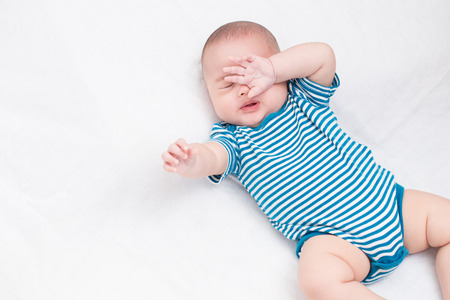In the first year of your baby’s life, this is one thing you will definitely stress about at some point of time. It could be your query that when will my baby sleep longer. All mothers go through this and so here are some sleep strategies and tips for new mothers. These are derived mainly from the experience of other moms and advice from experts. Babies tend to change sleeping patterns every few months so you will have to keep adapting to those changes in order to make your baby sleep at night soundly. But in all situations, these basic guidelines will remain constant.

Baby Sleep Strategies – Guidelines
- Sleep Signs : It is very important to recognize the signs that your little one needs a nap before you follow sleep strategies. The baby will get cranky, start pulling at the ears and also rubbing the eyes. It is best if you can identify these signs and get him ready to sleep. If you allow the baby to play after he is sleepy, he may become overtired and find it all the more difficult to settle down.
- Dim The Lights : When getting ready to make your baby sleep, dim the lights so that he knows that it is night time. In the first few weeks babies have no day or night rhythm and so they wake up what may seem to you a thousand times a day. Gradually their bodies get into sync with the time of the day. During the day time keep all windows open and let the house be full of light and sounds like the doorbell, barking dog etc. These will help the baby differentiate day from night. If your baby wakes up at night, keep the lights off and use a dim light to hold him or change his diaper. This will help him fall asleep again faster.
- Bed Time Routine : When putting the baby to sleep follow a sleep routine, and this is one of the foremost sleep strategies to follow. This should include a bath, pajamas, a bedtime story followed by a soothing routine which could be breastfeeding, rocking, swinging or swaddling. Try to follow the same sequence of events everyday as babies love predictability and such routines help baby sleep easily. However, with a baby not sleeping through the night, it gets important that you understand the other possible reasons such as colic, hunger, etc.
- Put Down The Baby When Drowsy : This is a golden rule to developing good baby sleep habits. Rock or feed your baby to sleep but do not wait till they are fast asleep. Put them down when they are still drowsy and let them finish the last bit of going to sleep on their own. If you are able to do this then the baby will sleep longer stretches and even if he does wake up at night, he will be able to soothe himself back to sleep. There are some babies who are more difficult and fussy and they may wail out loud the minute you put them in the crib. If you notice that your baby likes to feed to sleep, you can consider using a pacifier. Another sleep aid for babies is using a white noise machine that creates a humming sound which helps the baby sleep. Putting the baby in a rocking cradle helps to calm the baby and put him to sleep.
- Co-Sleeping : Co-sleeping means keeping the baby on the same bed that you sleep. Many mothers may like the idea better than putting the baby in the crib or bassinet. There are many advantages of co sleeping and the most important is physical contact. The mothers touch provides the baby with a sense of security and helps him sleep better. If you are a breast-feeding mom, then this will work for you because feeding in lying down position is much easier. Feeding to sleep works well for the baby and the mother. The only caution here is of SIDS. Sudden infant deaths are commonly seen when babies are kept in the same bed. The excessive bedding and a deep sleeper are the things that you should avoid having around your baby when he sleeps. Precautions: Whether you put your baby in the crib or on the bed, these pointers should be kept in mind while following these sleep strategies.
- Avoid putting soft toys, blankets and bedding around the sleeping baby. If the baby is small and cannot turn his head then there is a risk of suffocation.
- The crib should be completely free from any bedding. Put the baby to sleep on his back and not on the stomach.
- During the day time, if you put the baby down for a small nap, you can use a baby sleeping pillow.
- Keep the room free from smoke or smell of alcohol.
- Put the baby to sleep beside you and then slowly move him into the co sleeper. You can get the baby close when you need to feed him.
- Avoid bright light and sounds in the room where you plan to put your little one to sleep.

Baby Crying to Sleep
- Cry It Out : This is another method where the baby is allowed to cry for a few minutes and self soothe himself back to sleep. If you try to follow this, do not jump at the first cry or sound that you hear on the baby monitor. Wait for a while and give the baby time to fall asleep again. He may wail if he doesn’t see you around. Give him a few minutes and then enter the room and hold him to calm him down. Gradually increase the time you give him and reduce the soothing episodes. If you are lucky, you will notice that in a week’s time, your baby will shift and turn around and sleep again on his own. This method is also called ferberizing. The best time to implement this sleep training method is between 4 to 8 months of age. Never try this on newborns as they need to be attended to immediately.
- Learn About Sleep Regressions : It is very normal for babies who sleep normally to begin waking up and crying at night. These changing baby sleep patterns are nothing but sleep regressions. They are very common when the baby is nearing a major developmental milestone like crawling, turning over etc. Teething, a new sibling, travel or an illness can also cause disturbance in the sleep. The common sleep regressions are seen at 4 months and again at 9 months when the separation anxiety is at its peak. These waking are temporary and will go away in a few days. You need not worry with such changes. Following these sleep strategies will slowly but effectively help you make your baby fall to sleep without fuss.




